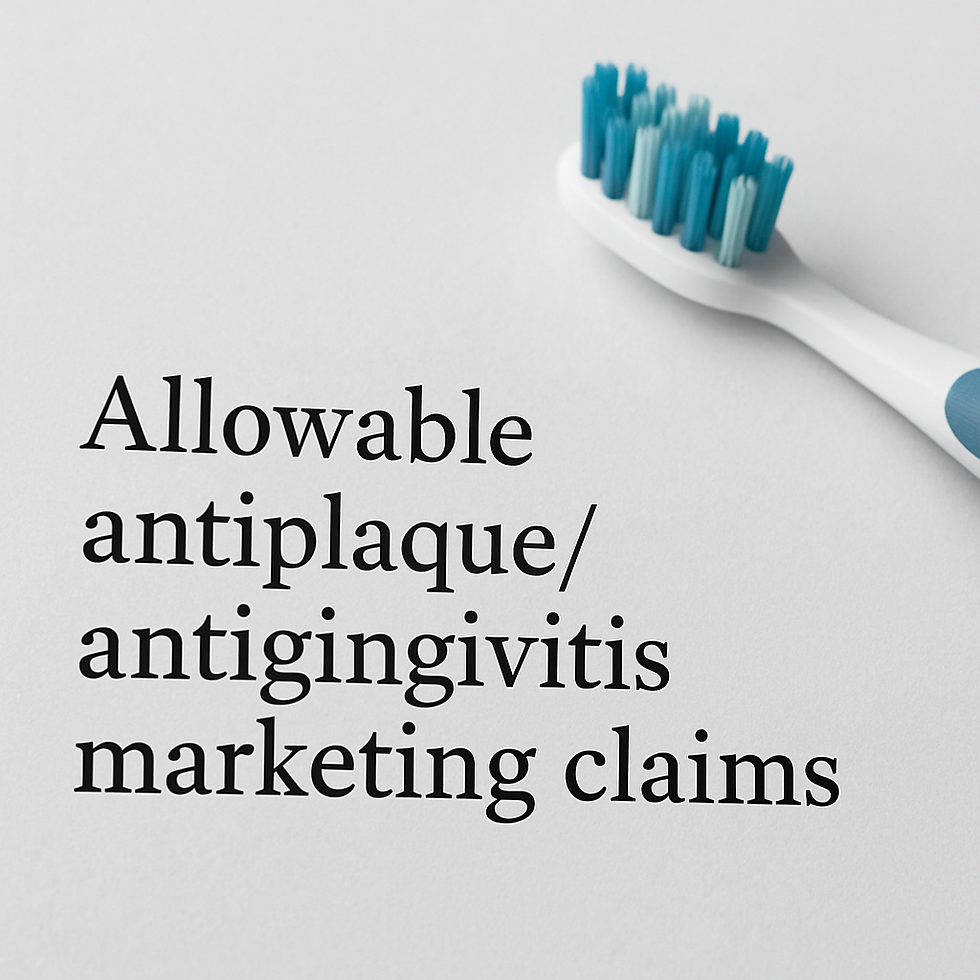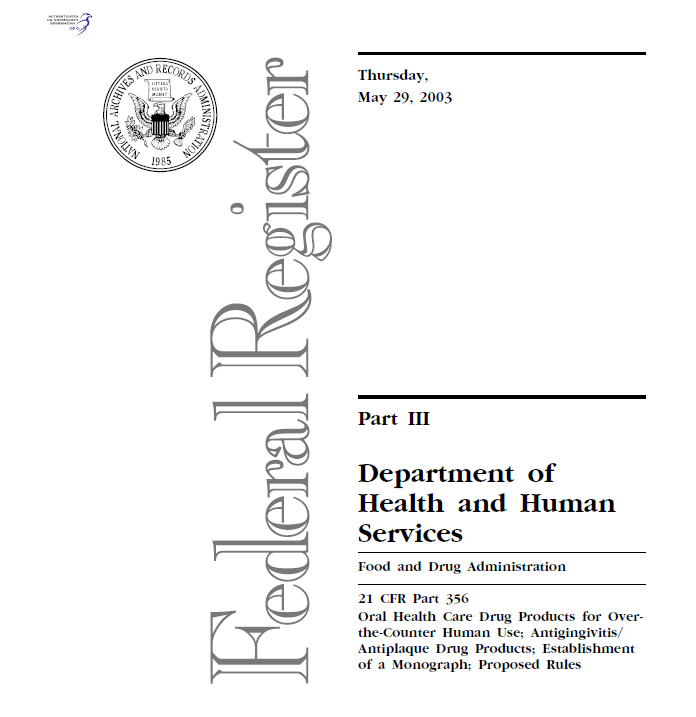Understanding Allowable Antiplaque and Antigingivitis Marketing Claims in OTC Oral Care Products
- Evan Howard
- May 20
- 7 min read
The U.S. Food and Drug Administration (FDA) regulates over-the-counter (OTC) oral health care drug products through a series of monographs, which are essentially rule books, and recipe books, that specify which active ingredients, claims, and labeling are allowed for specific categories of products. The monograph for antiplaque and antigingivitis drug products, found in 21 CFR 356, establishes the conditions under which these products are generally recognized as safe and effective (GRASE) for consumer use without a prescription. This regulatory framework is critical not only for manufacturers seeking to market oral health products but also for dental professionals and consumers who rely on these products for daily oral hygiene.

The monograph process began in response to the need for standardized, evidence-based guidelines for OTC drug products. For antiplaque and antigingivitis agents, the FDA convened expert advisory panels and subcommittees to review scientific data, clinical trial results, and public comments. Their recommendations form the backbone of the monograph, ensuring that only those products proven to be both safe and effective reach the market. The ultimate goal is to protect public health while providing clear, truthful information about the benefits and appropriate use of these products.
FDA Ingredient Classification System for OTC Drug Monographs
The FDA uses a three-category system to classify active ingredients in over-the-counter (OTC) drug monographs, based on their safety and effectiveness for specific uses. Category I ingredients are those determined to be both safe and effective for their intended purpose, allowing them to be marketed without a prescription under the monograph. Category II ingredients are not considered safe and effective, or have unacceptable indications, and therefore cannot be marketed for those uses. Category III ingredients are those for which the available data are insufficient to make a final determination on safety and effectiveness, meaning they cannot be marketed for the intended use until further evidence is provided and a final classification is made
Category | Meaning | Regulatory Status |
Category I | Generally Recognized as Safe and Effective (GRASE) for the claimed therapeutic indication | Allowed for OTC use under the monograph; may be marketed without a new drug application. |
Category II | Not Generally Recognized as Safe and Effective or has unacceptable indications | Excluded from the monograph; cannot be marketed for that indication as an OTC drug. |
Category III | Insufficient data available to permit final classification as safe and effective | More research/data required; may not be marketed until reclassified as Category I or II. |
Active Ingredients Reviewed by the Subcommittee
The heart of the monograph lies in its review of active ingredients. The Dental Plaque Subcommittee, an expert group convened by the FDA, conducted a thorough evaluation of the scientific literature and clinical trial data to determine which ingredients could be classified as safe and effective for reducing or preventing dental plaque and gingivitis. This process involved not only assessing the pharmacological properties of each ingredient but also considering their performance in long-term, randomized clinical trials.
Among the most commonly reviewed and ultimately accepted active ingredients are:
Chlorhexidine: Often referred to as the "gold standard" for antiplaque and antigingivitis efficacy, chlorhexidine is a broad-spectrum antiseptic with both bacteriostatic and bactericidal effects. Its ability to bind to oral tissues provides a prolonged antibacterial action, making it highly effective in reducing plaque and gingivitis.
Stannous Fluoride: This ingredient is well known for its dual action in both caries prevention and gingivitis reduction. Stannous fluoride not only strengthens enamel but also interferes with the formation and effects of dental plaque, thereby reducing inflammation and bleeding of the gums.
Cetylpyridinium Chloride: As a quaternary ammonium compound, cetylpyridinium chloride exhibits antimicrobial properties by disrupting bacterial cell membranes. It is commonly found in mouthwashes and has demonstrated efficacy in reducing plaque and gingivitis in clinical studies.
Essential Oils (Fixed Combination): Products containing a fixed combination of essential oils (such as eucalyptol, menthol, methyl salicylate, and thymol) have been shown to reduce both plaque and gingivitis. These combinations are permitted under the monograph when formulated and labeled according to specific guidelines.
The subcommittee's evaluation was thorough, requiring evidence from well-conducted clinical trials, typically of at least six months' duration, to demonstrate a statistically significant reduction in plaque and gingivitis compared to placebo or control products. Only those ingredients meeting these standards were recommended for inclusion in the monograph as Category I (safe and effective).
Other active ingredients reviewed by the subcommittee but not deemed safe or effective are:
Zinc Citrate: Classified as safe for use in oral care products, but the subcommittee concluded that there was insufficient evidence to support its effectiveness in reducing plaque or gingivitis. As a result, it was not included as a Category I ingredient and cannot be marketed for these claims without further supporting data.
Dicalcium Phosphate Dihydrate: Commonly used as a mild abrasive in toothpaste formulations to help physically remove debris from teeth. However, the subcommittee found no sufficient clinical evidence that it provides direct antiplaque or antigingivitis effects, and it was not recognized as a safe and effective active ingredient for these specific claims.
Hydrogen Peroxide: Considered for its antimicrobial activity, but the subcommittee found insufficient evidence to support its use in reducing plaque or gingivitis at concentrations safe for daily oral use. Potential for mucosal irritation and lack of efficacy data led to its exclusion.
Sanguinaria Extract. An alkaloid derived from the bloodroot plant, was once used in mouthwashes and toothpaste for its purported antiplaque effects. The subcommittee determined that the available clinical data were inadequate to establish either safety or efficacy, and concerns about mucosal irritation further precluded its approval.
Sodium Bicarbonate. Also known as baking soda, sodium bicarbonate is often included in toothpaste for its mild abrasive properties, but the subcommittee found no evidence that it provided clinically significant antiplaque or antigingivitis effects. It was therefore not included as an approved active ingredient for these indications.
Sodium Lauryl Sulfate. Commonly used as a detergent in toothpaste, was proposed for its potential antiplaque effects. The subcommittee determined that there was no robust evidence of efficacy, and concerns about mucosal irritation further weighed against its approval.
Allowable Claims: Prevention or Treatment
A central function of the monograph is to define which marketing claims are permitted for antiplaque and antigingivitis products. The FDA, guided by the subcommittee's recommendations, has established a set of allowable claims that manufacturers can use on product labeling and advertising. These claims are designed to be both truthful and not misleading, providing consumers with clear information about what the product can reasonably be expected to do.
Allowable claims generally fall into two categories: prevention and treatment. A prevention claim indicates that the product helps to stop the onset of gingivitis or plaque accumulation, while a treatment claim means the product can reduce existing gingivitis or plaque levels. The monograph permits the following types of statements, often with interchangeable verbs to reflect the product's full range of benefits:
"Helps control, reduce, or prevent gingivitis."
"Helps control, reduce, prevent, or remove plaque that leads to gingivitis."
"Helps interfere with the harmful effects of plaque associated with gingivitis."
"Helps reduce plaque that leads to gingivitis, an early form of gum disease, and/or bleeding gums."
For products containing stannous fluoride or fixed combinations of essential oils, additional claims may be used to reflect their dual action on both plaque and gingivitis. The subcommittee emphasized that limiting products to a single verb such as "control," "reduce," or "prevent" would not adequately inform consumers, as many products are effective for both existing conditions and prevention of future disease.
It is crucial to note that these claims must be supported by robust clinical evidence, as determined by the subcommittee's review. Any claim that goes beyond the scope of the monograph, such as suggesting a cure for periodontitis or other advanced gum diseases, is not permitted for OTC products and would require separate regulatory approval.
When Is a New Drug Application Required?
While the monograph provides a pathway for the majority of OTC antiplaque and antigingivitis products, there are important limitations. If a product contains an active ingredient not listed in the monograph, or if it combines multiple active ingredients in a way not specifically permitted, or a claim is being made regardless of ingredients, the manufacturer must submit a New Drug Application (NDA) to the FDA for review and approval.
The subcommittee did recommend that certain combinations of active ingredients be recognized as safe and effective, specifically:
An antiplaque/antigingivitis ingredient with an anticaries ingredient (such as fluoride).
An antiplaque/antigingivitis ingredient with a tooth desensitizer ingredient.
An antiplaque/antigingivitis ingredient with both an anticaries and a tooth desensitizer ingredient.
These combinations were found to be rational and supported by scientific evidence, and the subcommittee urged the FDA to include them in the monograph as Category I. However, if a manufacturer wishes to market a product with a novel combination not explicitly covered by the monograph, or with a new active ingredient, an NDA is required. This ensures that any new claims or combinations are subject to the same rigorous safety and efficacy standards as those already included in the monograph.
A relevant case addressing combination products is United States v. Articles of Drug... Colgate Palmolive Co., 518 F. Supp. 1174 (D.N.J. 1981). In this case, the court held that a product combining multiple active ingredients not specifically permitted under the existing monograph could not be marketed as an OTC drug without prior FDA approval through the NDA process. The decision reinforced the principle that the monograph system is designed to protect consumers by ensuring only thoroughly evaluated products are available without a prescription.
The 21 CFR 356 monograph for antiplaque and antigingivitis drug products represents a comprehensive, evidence-based approach to regulating OTC oral health products in the United States. By clearly defining which active ingredients are safe and effective, specifying allowable claims, and outlining the circumstances under which a New Drug Application is required, the monograph provides a transparent framework for manufacturers, clinicians, and consumers alike. As scientific knowledge advances and new ingredients or combinations are developed, the monograph process ensures that public health remains the top priority.
Howard Law is a business, regulatory and M&A law firm in the greater Charlotte, North Carolina area, with additional services in M&A advisory and business brokerage. Howard Law is a law firm based in the greater Charlotte, North Carolina area focused on business law, corporate law, regulatory law, mergers & acquisitions, M&A advisor and business brokerage. Handling all business matters from incorporation to acquisition as well as a comprehensive understanding in assisting through mergers and acquisition. The choice of a lawyer is an important decision and should not be based solely on advertisements. The information on this website is for general and informational purposes only and should not be interpreted to indicate a certain result will occur in your specific legal situation. Information on this website is not legal advice and does not create an attorney-client relationship. You should consult an attorney for advice regarding your individual situation. Contacting us does not create an attorney-client relationship. Please do not send any confidential information to us until such time as an attorney-client relationship has been established.



Comments